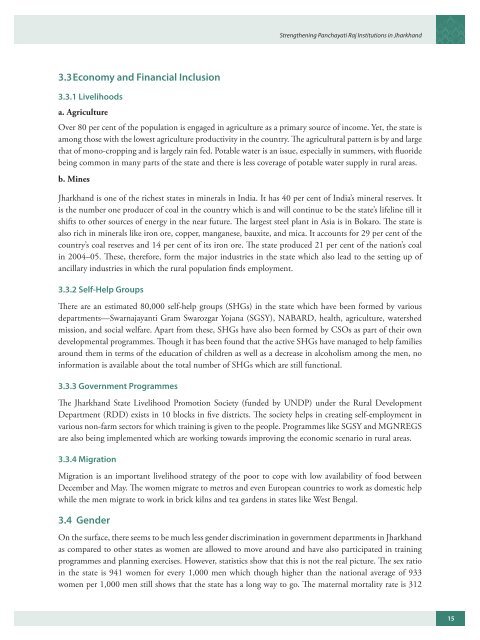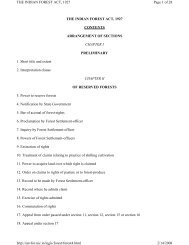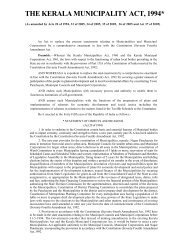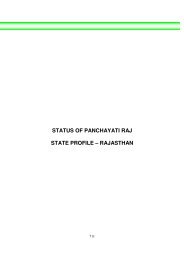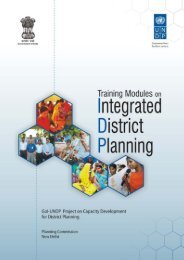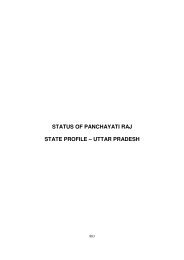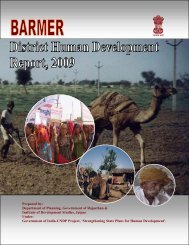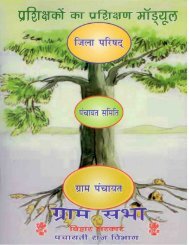for Strengthening Panchayati Raj Institutions in ... - PRI Resources
for Strengthening Panchayati Raj Institutions in ... - PRI Resources
for Strengthening Panchayati Raj Institutions in ... - PRI Resources
You also want an ePaper? Increase the reach of your titles
YUMPU automatically turns print PDFs into web optimized ePapers that Google loves.
<strong>Strengthen<strong>in</strong>g</strong> <strong>Panchayati</strong> <strong>Raj</strong> <strong>Institutions</strong> <strong>in</strong> Jharkhand3.3 Economy and F<strong>in</strong>ancial Inclusion3.3.1 Livelihoodsa. AgricultureOver 80 per cent of the population is engaged <strong>in</strong> agriculture as a primary source of <strong>in</strong>come. Yet, the state isamong those with the lowest agriculture productivity <strong>in</strong> the country. The agricultural pattern is by and largethat of mono-cropp<strong>in</strong>g and is largely ra<strong>in</strong> fed. Potable water is an issue, especially <strong>in</strong> summers, with fluoridebe<strong>in</strong>g common <strong>in</strong> many parts of the state and there is less coverage of potable water supply <strong>in</strong> rural areas.b. M<strong>in</strong>esJharkhand is one of the richest states <strong>in</strong> m<strong>in</strong>erals <strong>in</strong> India. It has 40 per cent of India’s m<strong>in</strong>eral reserves. Itis the number one producer of coal <strong>in</strong> the country which is and will cont<strong>in</strong>ue to be the state’s lifel<strong>in</strong>e till itshifts to other sources of energy <strong>in</strong> the near future. The largest steel plant <strong>in</strong> Asia is <strong>in</strong> Bokaro. The state isalso rich <strong>in</strong> m<strong>in</strong>erals like iron ore, copper, manganese, bauxite, and mica. It accounts <strong>for</strong> 29 per cent of thecountry’s coal reserves and 14 per cent of its iron ore. The state produced 21 per cent of the nation’s coal<strong>in</strong> 2004–05. These, there<strong>for</strong>e, <strong>for</strong>m the major <strong>in</strong>dustries <strong>in</strong> the state which also lead to the sett<strong>in</strong>g up ofancillary <strong>in</strong>dustries <strong>in</strong> which the rural population f<strong>in</strong>ds employment.3.3.2 Self-Help GroupsThere are an estimated 80,000 self-help groups (SHGs) <strong>in</strong> the state which have been <strong>for</strong>med by variousdepartments—Swarnajayanti Gram Swarozgar Yojana (SGSY), NABARD, health, agriculture, watershedmission, and social welfare. Apart from these, SHGs have also been <strong>for</strong>med by CSOs as part of their owndevelopmental programmes. Though it has been found that the active SHGs have managed to help familiesaround them <strong>in</strong> terms of the education of children as well as a decrease <strong>in</strong> alcoholism among the men, no<strong>in</strong><strong>for</strong>mation is available about the total number of SHGs which are still functional.3.3.3 Government ProgrammesThe Jharkhand State Livelihood Promotion Society (funded by UNDP) under the Rural DevelopmentDepartment (RDD) exists <strong>in</strong> 10 blocks <strong>in</strong> five districts. The society helps <strong>in</strong> creat<strong>in</strong>g self-employment <strong>in</strong>various non-farm sectors <strong>for</strong> which tra<strong>in</strong><strong>in</strong>g is given to the people. Programmes like SGSY and MGNREGSare also be<strong>in</strong>g implemented which are work<strong>in</strong>g towards improv<strong>in</strong>g the economic scenario <strong>in</strong> rural areas.3.3.4 MigrationMigration is an important livelihood strategy of the poor to cope with low availability of food betweenDecember and May. The women migrate to metros and even European countries to work as domestic helpwhile the men migrate to work <strong>in</strong> brick kilns and tea gardens <strong>in</strong> states like West Bengal.3.4 GenderOn the surface, there seems to be much less gender discrim<strong>in</strong>ation <strong>in</strong> government departments <strong>in</strong> Jharkhandas compared to other states as women are allowed to move around and have also participated <strong>in</strong> tra<strong>in</strong><strong>in</strong>gprogrammes and plann<strong>in</strong>g exercises. However, statistics show that this is not the real picture. The sex ratio<strong>in</strong> the state is 941 women <strong>for</strong> every 1,000 men which though higher than the national average of 933women per 1,000 men still shows that the state has a long way to go. The maternal mortality rate is 31215


